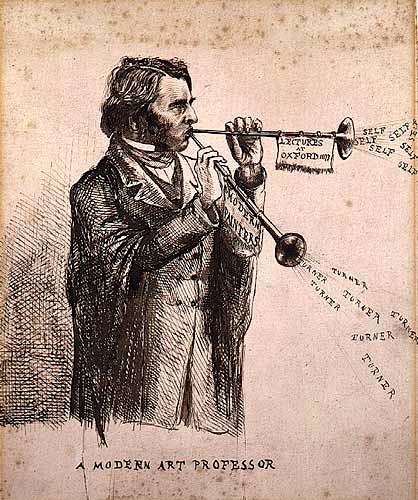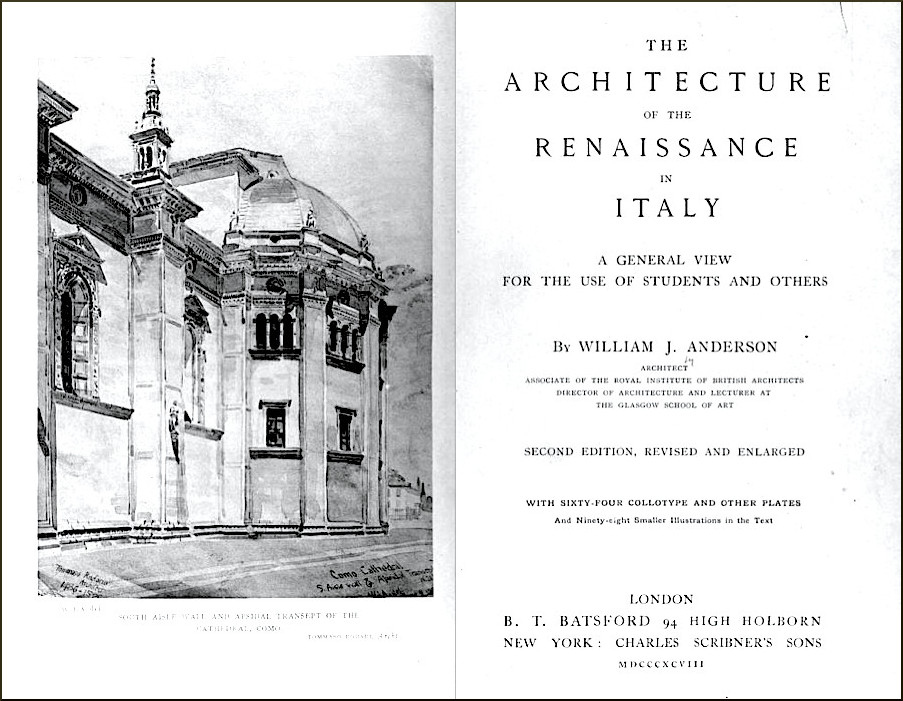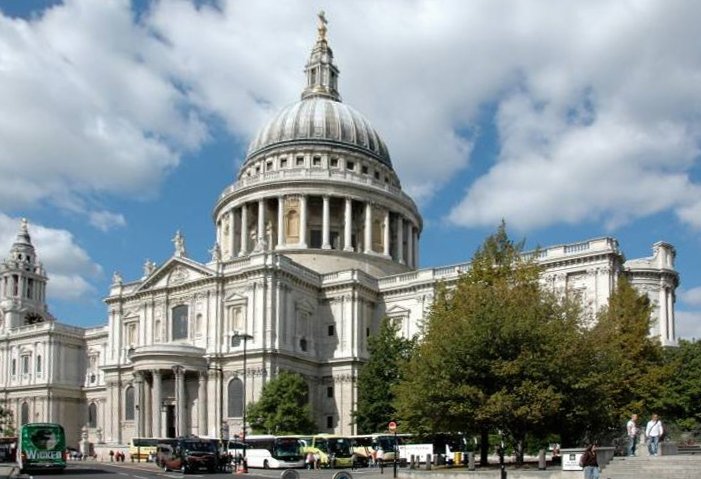[Unless otherwise stated, all quotations are from the book under review, and all illustrations come from our own website. Click on the thumbnails for larger images, and to find out more about them.]

Cover of the book under review.
Katherine Wheeler's title, like her writing in general, is perfectly and succinctly accurate: Victorian Perceptions of Renaissance Architecture is a scholarly study of how and why opinion about the architecture of the early sixteenth to late eighteenth centuries changed during the Victorian period. This might seem narrowly specialised, but it is just the opposite. Wheeler throws more light on the built environment by looking at influential thinkers of the age than by running through the usual list of Victorian revivals or identifying trends set by individual practitioners in different categories of buildings or different regions. This is largely because shifts in thinking about style were closely involved with, if not triggered by, the development of architecture as a profession at this time. Since the new generations of architects started out as students and then became educators and leaders in this profession, their work and their pupils' work inevitably reflected these shifts. A few representative examples of recorded, planned or realised buildings are enough to illustrate Wheeler's points.
Ruskin on Renaissance Architecture

Caricature of Ruskin in c.1877 by Sir Reginald Blomfield. Ruskin is shown as a "Modern Art Professor," simultaneously bruiting the cause of "Self" and "Turner." Blomfield was one of the many who were provoked by Ruskin's stance on Renaissance architecture too. It took decades to answer his case against it. [Pen and brown ink, over traces of graphite, on Bristol board (272 x 225 mm), by kind permission of the Morgan Library and Museum of New York. Given by Antoinette Howell in memory of her husband, Warren Richardson Howell, 1984.35, and available offsite here.]
Wheeler's book is more bracing as well as more wide-ranging than it sounds. Not for nothing was the conflict about styles in the mid-Victorian period termed a battle: the main proponents of the Gothic style in building were highly opinionated, condemning the Renaissance out of hand. Chapter 1 does not quite begin with the first alarum. That is, Wheeler bypasses A. W. N. Pugin and his landmark writings in favour of Gothic, Contrasts of 1836, and True Principles of 1843, to start with John Ruskin instead. She admits later in the chapter that Pugin's views had an impact, but feels that his "religious preferences were too extreme to be influential" (39). Puginites are not the only ones who might take issue here, and it is noteworthy that Rosemary Hill's biography of Pugin is not listed in Wheeler's long bibliography at the end. Be that as it may, Wheeler argues fairly enough that Ruskin's equally strident and sweeping objections to Renaissance architecture, unyoked from Catholicism, carried greater weight with a larger audience. To Ruskin, on more general grounds,
Architecture in Renaissance Italy reflected the period's declining social morality, loss of religious faith, and erosion of craft. Renaissance architecture was sinful in Ruskin's view, because it embodied the immorality of its creators and the society at large. Ruskin recognized these faults in the architecture of his own day, and he drew a direct connection back to the "fall" of architecture in the Renaissance.
Ruskin's view was indeed a broad one, extending to a belief that architecture in this style had a generally and increasingly "dehumanizing" effect:
Ruskin mourned the alienation that he felt was damaging modern Britain and dehumanizing the contemporary artisan. In both The Stones of Venice (1851-1853) and his earlier work The Seven Lamps of Architecture (1849), Ruskin romanticized an architecture grounded in craft and the personal expression of the artisan—architect, who observed truth and beauty in nature. The quickly evolving world of the nineteenth-century building industry, with its adoption of new materials and technologies stemming from the Industrial Revolution, irrevocably changed the practice of architecture. Ruskin was sounding an alarm and drawing the lines for a debate not only about style — Gothic versus Renaissance — but also about morality and professionalism. [19]
As Wheeler suggests, even if what Ruskin said was not new, it was put in a compelling way as part of a much larger vision of what was wrong with contemporary life, and proved hugely influential.


Left: La Chiesa di San Giorgio Maggiore, Venice (1565-80). Ruskin severely criticised the construction of the temple part of Palladio's famous church, and found that it left the interior looking like an assembly hall (see his alphabetised "Venetian Index" at the back of Stones of Venice, Vol. III in Works XI). Right: Ruskin's preference, shown in a watercolour of part of a Venetian Gothic palace: Windows of the third and fourth order, Casa Sagredo, Grand Canal.
Nevertheless, the opposition was already arming itself. In an early foray, an anonymous pamphleteer argued that the style Ruskin was condemning was better adapted to the times, more susceptible of original treatment, more universal, and, unlike Gothic, pleasing in its "forms and proportions" even when not ornamented (26). Among others who enlisted on this side was a correspondent in The Builder who adopted the pen-name "Zeta," or simply "Z," and who saw Ruskin's views as an attack on the present practice of architect "and the whole of our actual system of secular architecture." These were not isolated voices. Tellingly, and rather amusingly, The Builder commented on the "excited wrath" of others who supported them, claiming that their views were too inflammatory even to print (qtd. 27-28). However, as Wheeler says, the editor may simply not have wished the journal to become embroiled in the conflict, because many of its readers would have been craftsmen and (of course) builders, who would probably have fallen in behind Ruskin. All this was in 1851, giving a fascinating insight into the earlier stages of the Battle of the Styles before matters really came to a head over the design of the new Foreign Office. Wheeler discusses this well-known episode later in the chapter.
Other useful discussions in this chapter concern Ruskin's contempt for the Crystal Palace, with its ready-to-assemble iron girders and glass panels (where was the craftsmanship?); and, equally symptomatic of developments that Ruskin would be unable to prevent, the growing professionalism and status of architects. This was demonstrated by the increasing number and clout of architectural journals; the eminence of the Institute of British Architects, which received its Royal Charter in 1837, and the proliferation of smaller architectural societies outside London; and the new provisions for architectural training.
For the time being, however, Ruskin's views prevailed. One proof of this was that when the equally outspoken James Fergusson wrote in his History of the Modern Styles of Architecture (1862) that the Renaissance was a "contagion," and that to return to the classical past for models was the "doom of Architecture" (qtd. 42), his argument went unchallenged.
Turning the Tide


Left: The Queen Anne Revival Swan House, 17 Chelsea Embankment, London, by Richard Norman Shaw (1876). Right: Houses in Bedford Park, London W4, by Norman Shaw and E. J. May, c. 1800.
From this point on, though, Wheeler deals with what she calls "the incremental shifts in perception that resulted in the Renaissance's acceptance" (7), partly because of a growing eclecticism on the part of practising architects themselves, and partly as a result of new views of the period, notably by Walter Pater (in Studies in the History of the Renaissance of 1873, and John Addington Symonds in The Fine Arts of 1877). As for the architects, the Queen Ann Revival style, as illustrated by Richard Norman Shaw and others at Bedford Park in the 1870s, had something of both the Gothic (in picturesque outline) and the Renaissance (in details such as oriels and dormers), and soon proved popular. As for the latter, Wheeler suggests that Pater and Symonds both in their own ways encouraged new attitudes, Pater viewing the Renaissance as a transitional movement, making it harder to oppose it to the Gothic, and Symonds stressing the liberating and progressive attitudes that informed the Renaissance. This kind of interdisciplinary work, showing how the writings of the aesthetes impacted on the practitioners, is very helpful.
Architect-Authors

Frontispiece ("South aisle wall and apsidal transept of the Cathedral, Como") and title page of the revised and extended second edition of Anderson's student textbook, The Architecture of the Renaissance in Italy (1896), showing Renaissance studies now firmly entrenched in academia. Ironically, in §35 of Volume I of The Stones of Venice, Ruskin had cited this very cathedral as an example of the corruption of the Gothic! Source: Internet Archive book contributed by the University of California Libraries.
By this time, architectural training was already becoming formalised. The Architectural Association (the AA) was founded as early as 1847, under the inspiration of Robert Kerr (1823-1904), who was appointed Professor of the Arts of Construction at King's College London in 1861. But it was with another architect-educator, William James Anderson (1863-1900), that the tide really turned for Renaissance studies. Associated with various important Scottish architects, including William Leiper, and elected President of the Glasgow Architectural Association in 1890, Anderson began lecturing at the Glasgow School of Art in 1893, and in the following year became Director of the Architectural School. Following his Architectural Studies in Italy (1890), Anderson's The Architecture of the Renaissance in Italy: A General View for the Use of Students and Others (1896) described "the architecture of the Italian Renaissance, in particular that of the early sixteenth century," as exemplifying "the perfected period of the whole classical revival" (76). Refuting the arguments of Ruskin and Fergusson, "It is time to be rational," Anderson insisted, "and to leave off such characterisation of Renaissance architecture as a plague or a pestilence, a sham or a scenic affectation" (78). As for Fergusson's ethnographically-based argument that each race should produce its own characteristic architecture, Anderson responded by formulating a united European people, and claiming that the architectural heritage of Italy was equally that of the British. Nor was this heritage something static, he said. In the now popular idiom of the day, he described it as evolving in an entirely natural way from the medieval periods onwards, to be brought forward rather than simply imitated. Wheeler's discussion is admirably detailed, and gives Anderson an important place in the history of architectural thought and studies.
Anderson's own life showed how the profession was changing, and how much weight now lay on the individual architect in charge of a project. He was blamed for five fatalities that occurred on a major commission of his, the model tenement block of Napier House on Govan Road in Glasgow. The fault was later considered to lie with "improper formwork and a poor concrete mix" but the stress had been too much for him, and he took his own life following a nervous breakdown (72).
The new professionalism of the architectural establishment was now impinging on the students as well, who had to study the history and design of Renaissance architecture in detail for their examinations. This part of Wheeler's book reveals the growing sense of division between the architect, now highly trained and based primarily in his office, and the builders and craftsmen who worked from his drawings, either on site or in workshops, to execute his plans. This was just what Ruskin had feared. The architect John Dando Sedding was an outspoken critic of the development, and it was in response to this rift between architect and artisan that many architects petitioned the President of the RIBA in a signed "memorial" not to make the profession a closed one, separate from the other arts, for which practitioners had to qualify through examination. The "Memorialists" included such well-known names as Norman Shaw, Leiper, William Lethaby, Edward Burne-Jones — and William Morris. But neither the Arts and Crafts Movement, nor Lethaby's promotion of experimentation, could stop the trend. These different visions for architecture as one of the fine arts, indeed as the umbrella under which all of them belong, are much treasured now, but they were actually short-lived. The importance of the School of Architecture at King's College, London, headed from 1890 by the practising architect, architectural historian and educator Banister Fletcher, demonstrated the new place of architecture in the more rarefied air of academe. And here, of course, the Renaissance was part of every would-be architect's curriculum.
The English Renaissance Style in Architecture


Models of the English Renaissance: Left: The Queen's House by Inigo Jones, started in 1616. Right: St Paul's Cathedral by Sir Christopher Wren, started in 1675.
The history of the Renaissance was now being rewritten by architect-authors. Towards the end of the century they proclaimed that just as the Gothic impulse had never really died, so too the classical one, valuing due proportion and symmetry, with prescribed detailing, had deep roots in the British psyche. The English Renaissance style was now seen, Wheeler explains in her fourth chapter on J. Alfred Gotch (1852-1942) and Sir Reginald Blomfield (1856-1942), as "[a] hybrid of both English Gothic and Italian Renaissance styles," incorporating "characteristics of both traditions." The architectural writers of this later nineteenth-century period "typically divided the English Renaissance into two periods, an early and a late, corresponding to the introduction of Italian influences and when they began to dominate English Gothic traditions" (103). The seminal, and still the most important, history of the style was Blomfield's The History of Renaissance Architecture in England (1897). Blomfield began his narrative with Henry VIII's invitation of Italian craftsmen to England in the 1510s, although most would now agree that the style was established a little later than that, in about the 1540s. Its best examples came later still, with the work of Inigo Jones (1573-1652) and Sir Christopher Wren (1632-1723). This was a way of looking at architectural history in England that owes much not only to Blomfield but to John Belcher (1841-1913) and Sir Mervyn Macartney (1853-1932), co-authors of Later Renaissance Architecture in England, also first published in 1897. The Renaissance was respectable again. It had, in short, been rehabilitated.


New models of the English Renaissance: Left: J. Alfred Gotch's restored Madingley Hall, Cambridge. Right: John Belcher and Arthur Beresford Pite's Institute for Chartered Accountants Building in Moorgate, London, opened in 1893.
Towards the Modern
Wheeler's last chapter focuses on the architectural historian Geoffrey Scott (1884-1929), who had studied at Oxford under the great classical scholar Gilbert Murray (1866-1957). Scott's highly influential work, The Architecture of Humanism: A Study in the History of Taste (1914), proved pivotal. Introducing a new category ("theory") to the RIBA's examination booklists, it "reframed the Renaissance by refuting the prejudices of earlier authors such as Ruskin and preserved it as a crucial topic of architectural study by shifting the focus to abstract principles" (125; Ruskin took a great deal of refuting!). Defining structure itself as the source of aesthetic pleasure, and favouring empathy over the discrimination of various elements of style, Scott opened the way to a broad concept of Renaissance architecture that could provide a basis for modern experiments not only at home but across the globe: Blomfield, now described as one of "the old guard" (131) disliked it, but, as Wheeler says, "Edwardian Baroque architecture, with its loose interpretation of Renaissance and Baroque elements, manifested many of Scott's ideas of aesthetic expression" (138).

Design for new premises for the Royal Society of Medicine in Henrietta Street, London (1912), by Belcher, this time in partnership with John James Joass (1868-1952), using Renaissance elements in a distinctly modern way.
In her conclusion, Wheeler warns against over-simplifications — against linking together too tightly the Gothic Revival, the Arts and Crafts Movement, and socialism, and then contrasting them "too extremely with the myths of the Renaissance." Why? Because, she admits, "there were certainly overlaps and shared nuances" (158). For obvious reasons, these "overlaps" and "nuances" have not been her focus. For example, Blomfield was indeed one of the "old guard," who for a long time kept a foot in both camps: not mentioned here is the fact that he finally retired from the Art Workers' Guild only in 1923. Rather, Wheeler's main purpose has been to show how a seemingly despised and outmoded style of building found champions as well as detractors during the nineteenth century, continued to be used (as she does mention) for commercial premises such as warehouses and banks, and came to predominate again as the Gothic Revival faded and architecture became an academic subject. This purpose she has achieved admirably, and in more depth than I have been able to indicate in this short review. It is remarkable, really, and yet another tribute to the power of Ruskin's rhetoric, that Renaissance architecture should have needed a new spokesperson who could explain this development thoroughly and lucidly. But it did, and it has found one here.
Related Material
- "The Quarry," Chapter I, The Stones of Venice
- Charles Eastlake on Ruskinism
- Victorian Doubt, Victorian Architecture, and the Battle of Styles
- Architectural Books, and Professional and Trade Journals
- Architectural Historians and Theorists
Book under Review
Wheeler, Katherine. Victorian Perceptions of Renaissance Architecture. Farnham, Surrey: Ashgate Press, 2014. 194 + xii pp. £55.94. ISBN: 9-781-4724-1882-1.
Last modified 29 November 2014